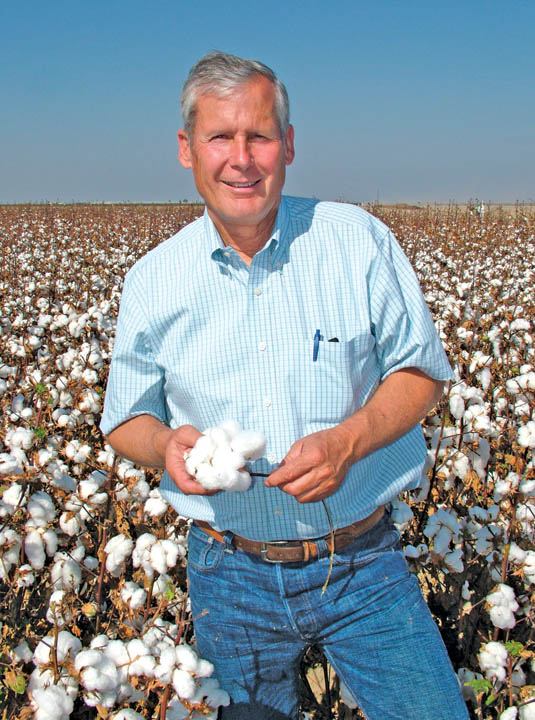
The High Cotton Awards, sponsored by Farm Press Publications through a grant to The Cotton Foundation, are presented annually to cotton producers in each of the four Farm Press coverage areas who produce good cotton yields while taking good care of the land and water on their farms. This year’s winners: Southeast Region— Kent Wannamaker, St. Matthews, S.C.; Delta Region — Coley Bailey Jr., Coffeeville, Miss.; Southwest Region — Shawn Holladay, Lamesa, Texas; and Far West Region — Don Cameron, Helm, Calif.

The TV series “Survivor” continues to command a loyal following among viewers who spend up to an hour each week watching their favorite contestant overcome one challenge after another to compete for immunity and a $1 million prize.
While they may not be big fans, each of the winners of this year’s High Cotton Awards can relate to the Survivor contestants. All have overcome challenges that might have proved too daunting for others on their way to building successful farming operations.
The High Cotton Awards, sponsored by Farm Press Publications through a grant to The Cotton Foundation, are presented annually to cotton producers in each of the four Farm Press coverage areas who produce good cotton yields while taking good care of the land and water on their farms.
This year’s winners:
Southeast Region— Kent Wannamaker, St. Matthews, S.C.
Delta Region — Coley Bailey Jr., Coffeeville, Miss.
Southwest Region — Shawn Holladay, Lamesa, Texas
Far West Region — Don Cameron, Helm, Calif.
They will be honored during a breakfast at this year’s Beltwide Cotton Conferences in Orlando, Fla. The Conferences, held by the National Cotton Council, attract hundreds of growers intent on learning the latest information about cotton production, handling and marketing.
This year’s awards are co-sponsored by Ace Pump Company, All-Tex Seed, Americot/NexGen, Arysta LifeScience, Deltapine, Dow AgroSciences, Helena Chemical Company, John Deere, MANA Crop Protection, Syngenta and U.S. Borax.
“These are some of the most environmentally conscientious producers we’ve featured in our 18 years of presenting the bronze Cotton Boll awards to our High Cotton recipients,” said Greg Frey, vice-president for the Penton Media Inc. Agricultural Group, which publishes Southeast, Delta, Southwest and Western Farm Press.
“Some of them have been farming for a while, but they always put the environment and taking care of their land and water first.”
Far West Region — Don Cameron, Helm, Calif.
Besides the usual challenges faced by farmers, California’s Don Cameron had to contend with soils that wouldn’t grow crops when he started farming near Helm in 1981.
“We had fields where alfalfa and wheat wouldn’t grow” because the white soils were virtually devoid of nutrients and loaded with salts, says Cameron. Today, he plants not only those, but 24 other crops on 7,000 acres in the San Joaquin Valley.
His farming career has been an ongoing initiative in reclamation, with Cameron using soil amendments like gypsum, soil sulfur and occasionally sulfuric acid and 35,000 tons of chicken litter annually from nearby poultry operations.
Cotton was Cameron’s moneymaker when he started farming there. “Cotton has bought and paid for a lot of farms on the West Side of the valley over the years,” he says. “Without cotton, we wouldn’t be here farming what we do today.”
Although cotton has struggled in recent years, Cameron believes it has a future in the San Joaquin Valley because of the demand for the high quality fiber produced there. Pima or extra long staple cotton has become the predominant variety after growers discovered it could yield with the traditional Acala varieties.
Another discovery that has helped Cameron and other California growers is the adoption of drip irrigation technology. Drip arrived in California in the mid-1970s. Now, virtually all new orchards and vineyards are established with some sort of micro-irrigation system.
About 80 percent of Cameron’s crops are drip-irrigated, which enables him to conserve water and reduce fertilizer applications. Both of the latter have become increasingly expensive in recent years.
He grows many organic crops, and is one of only two or three organic Pima growers in the U.S. He had 190 acres of organic Pima last year. Cotton is probably the most challenging crop to grow organically, he says, primarily because of the cost of mechanical weed control.
Southeast Region— Kent Wannamaker, St. Matthews, S.C.
For South Carolina’s Kent Wannamaker, just getting started in the business of farming was a challenge.
When he earned his degree from Clemson University, Wannamaker came back to St. Matthews and joined the farming operation begun by his grandparents. Then, in the mid-1980s, his father and uncle decided to retire from farming and put their land in the Conservation Reserve Program.
Thanks in large part to 30 acres of land given to him by his grandmother, Lucile Wannamaker, he was able to venture into the hog business. “My grandmother was a legend in her time,” he says. “She had her own farming operation, and she recognized early on that I wanted to be involved with farming.
Over the next 10 years, he gradually increased his farrow-to-finish operation to 500 sows, one of the state’s largest swine operations. When hog contracting became popular and there were fewer markets for independently raised hogs, Wannamaker realized it was time to diversify.
Row crop farming seemed the logical fit, but it was hard to find good farmland to rent in 1995. He had to forward pay land rent — something not commonly done in the area — just to convince landowners to take a chance on renting him their land.
In subsequent years, Wannamaker renovated an old, rundown soybean processing facility and converted it to a peanut-buying facility. Later, he and a group of farmers purchased a cotton gin. (Ironically, the gin was a competitor to one that had been owned and sold by his family when times were lean in the cotton business.)
Delta Region — Coley Bailey Jr., Coffeeville, Miss.
Farming in the hill country of Mississippi presents its own challenges, but Delta winner Coley Bailey Jr., has met those and more. Bailey has shown that you can combine efficiency and a conservation ethic to make cotton work in what many would consider not to be an ideal environment for cotton.
Bailey farms 3,350 acres of cotton with his father, Coley Bailey Sr., in Yalobusha and Grenada counties in central Mississippi. With farmland spread over two counties, reducing picking and handling time is more than just an idle objective.
During harvest, the Bailey’s work to keep picker dumps at a minute or less and to make sure equipment never sits idle for more than a few minutes. The attention to detail helps them to tarp up to 24 cotton modules a day with three pickers, three boll buggies and two module builders.
Because they, like most farmers in the hill country, have little irrigation, they try to make use of every drop of moisture that falls their way. Over the years, Bailey has used a combination of no-till farming, wheat cover crops and other conservation measures to conserve moisture.
Bailey is also taking steps to try to keep herbicide resistance at bay, adding different herbicides and herbicide modes of action to his weed management system. He and his father are also not opposed to using cold steel to remove weeds when necessary.
Southwest Region — Shawn Holladay, Lamesa, Texas
Southwest winner Shawn Holladay has faced a number of challenges during his farming career, but none compare to that posed by the record heat and drought Holladay and other Texas and Oklahoma growers experienced in 2011.
Even with the worst growing conditions most growers have ever seen Holladay’s commitment to stay with his production plan and to keep his land worked and ready to make a crop at all times never wavered.
“Farming tests your will at times,” says Holladay, who received only three-fourths of an inch of rain in 2011. “That’s all the rain we had for the entire season. About half our acreage finished the year without any measurable rainfall.”
Water conservation and irrigation efficiency were sorely tested. With limited rainfall, irrigation provides supplemental water to Southern Plains cotton producers and last year they relied on irrigation for virtually every drop of water the crop got.
Holladay plants mostly reduced-tillage cotton. “It’s an evolving program,” he says. “We have to till at some point, because of pivot tracks and other issues. We never stay with no-till for more than four years.”
His goal is a cropping system that provides organic matter, but doesn’t use a lot of water. Managing cover crops has become more difficult as the need for cover crops and the need to conserve water compete.
About the Author(s)
You May Also Like





